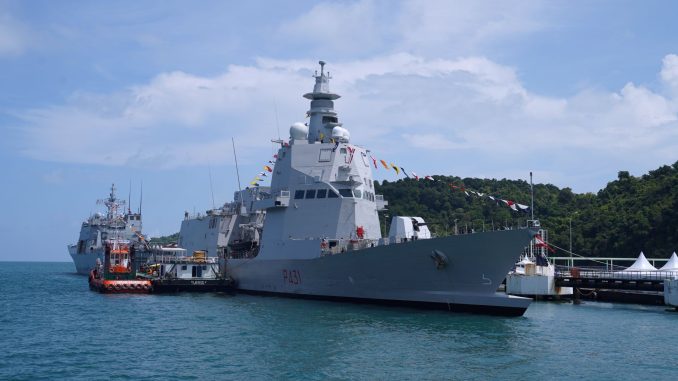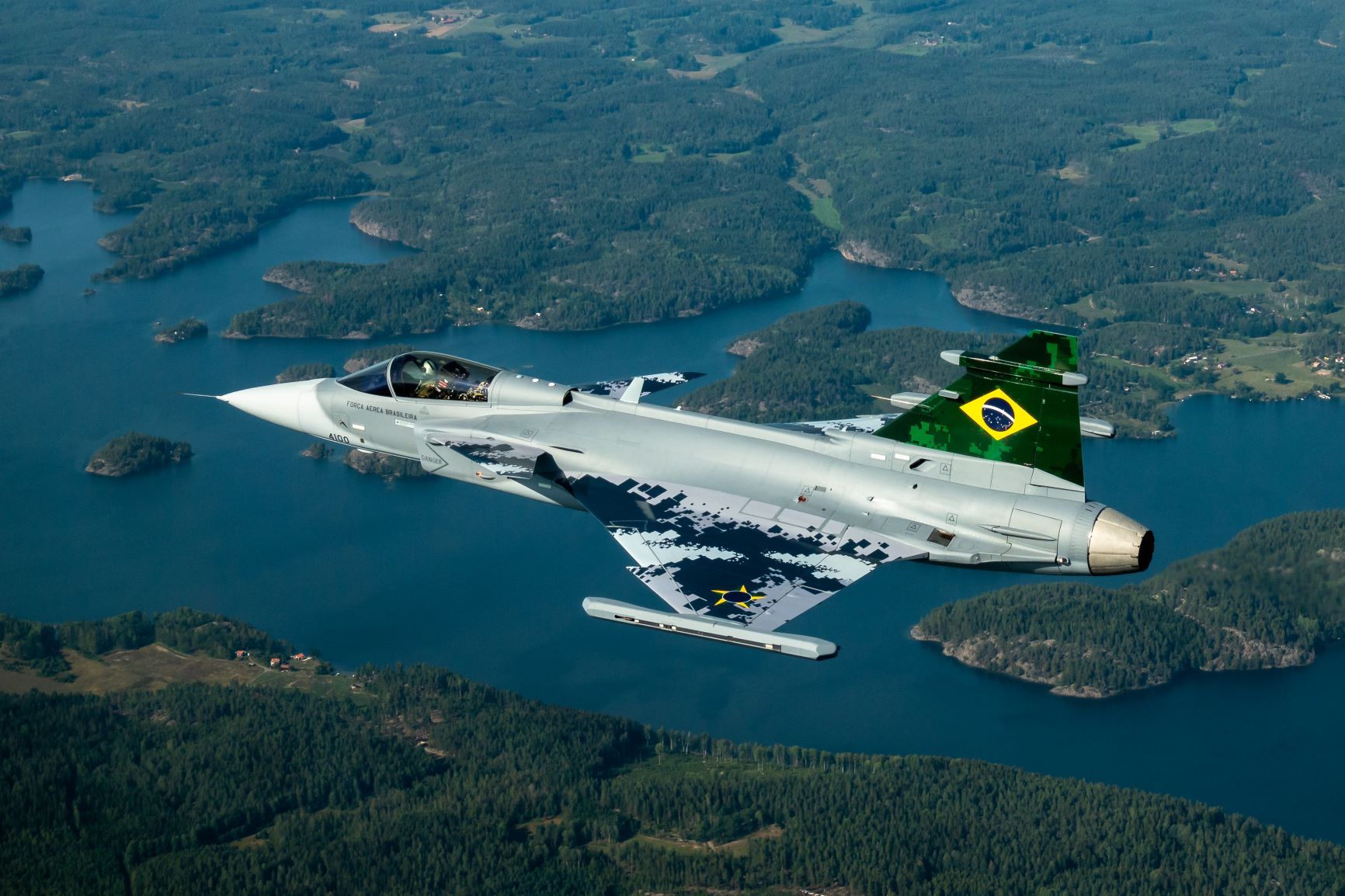
SHAH ALAM: Italian shipbuilder – Fincantieri has sign a 1.18 billion Euros (RM6 billion) contract to deliver two PPA (frigate size) ships with Indonesia. No details on the cost was provided but it is likely this will cover the ships as well as its armaments which includes anti-ship and anti air missiles, guns and other weapon systems.
The two ships were originally ordered by the Italian Navy and likely could be delivered by next year. For more details on the PPA class go here. The second of ship in the Thaon di Revel class – Francesco Morosini – took part in LIMA 2023.
The release from Fincantieri:
Fincantieri and the Indonesian Ministry of Defence have signed a 1.18-billion-euro contract, within the framework of collaborative relations initiated by the Italian Ministry of Defence, for the supply of two PPA Units. PPA is a highly flexible ship with an outstanding technological standard. It has the capacity to serve multiple functions, ranging from patrol with sea rescue capacity to Civil Protection operations and first line fighting vessel.
The contract was signed by Pierroberto Folgiero, CEO and Managing Director of Fincantieri, and by the Indonesian Ministry of Defence, in the presence of Dario Deste, General Manager of the Naval Vessels Division.
The ships subject to the order – originally destined for the Italian Navy – are currently under construction and fitting at the Integrated Shipyard in Riva Trigoso-Muggiano.
The interest of the Indonesian Ministry of Defence in PPA Units stems from the Maritime Campaign in the Far East of the Francesco Morosini, the second ship of the Italian Navy’s PPA class, which also stopped over in Indonesia in July 2023. The transaction can catalyze additional synergies in the operational, industrial, and technological fields between the two countries. The Units will be able to support Indonesia in protecting national interests and contribute to the stability of the delicate Indo-Pacific strategic quadrant.
As part of the transaction, Fincantieri will act as the prime contractor towards the Indonesian Ministry of Defence and will specifically coordinate the other industrial partners, including Leonardo, for the customization of the ships’ combat system and the provision of related logistic services. The parties will define the relevant agreements in compliance with the applicable legislation, including that relating to transactions between related parties.
The effectiveness of the contract is subject to the necessary authorizations from the competent authorities.
Characteristics of the PPA Unit
The vessel is capable of operating high-speed vessels such as RHIB (Rigid Hull Inflatable Boat) up to 11 meters long, with launching through lateral cranes or a hauling ramp located at the far stern.
• 143 meters long overall
• Speed more than 32 knots according to vessel configuration and operational conditions
• Crew of about 170 persons
• Equipped with a combined diesel, a gas turbine plant (CODAG) and an electric propulsion system
• Capacity to supply drinking water to land
— Malaysian Defence
If you like this post, buy me an espresso. Paypal Payment




Alhamdulilah
I have read somewhere that Indonesians procurement process sometimes different from other SEA countries like Singapore, Malaysia and Philipine. Sometimes they signed a contract without money allocation or approved. Thats maybe the reasons some contract that already signed or MOU easily to cancelled such as CBG batch 2, used Mirage jet etc.
Yup, one Indonesian commentator on Twitter said no allocation for the PPA has been approved.
No PSP (Penetapan Sumber Pembiayaan) has been allocated yet for this buy, as is for the FREMM.
The ships to be involved are :
MARCANTONIO COLONNA (Launch 26 Nov 22)
RUGGIERO DI LAURIA (launch 6 oct 23)
both in “Light+” config (with 16 Sylver A50 cells).
AFAIK, it is a done deal.
ID has laid their future fleet with more frigate and less Corvette up to 36 frigates. Their existing frigates are very old except the Martadinata class sigma 10514 light frigate. They need asap and PPA can fill in. It takes 4-5 years to build a 6000 tons frigate.
Even they must drop many acquisition military projects and shift the money to buy PPA.
Looking at the price they pay,they could get the full PPA variant.
ID will be 1st in Asean using aster 30 block 1NT whose range is 150km. It is possible they will put it on their merah putih AH140 frigate also.
Perhaps it will take 4 to 5 years for the first in class, but once the kinks are a 6000 tonnes frigate could also be completed in 3 to 4 years time.
Also it will be good to complete the first of class, first instead building the whole shebang, like what happened with our LCS….
As the project director once said to me when I asked the wisdom off building the whole six ships, we have build the Kedah class before so it will be easy….
We will have to wait and see as they also signed a deal to buy 8 FREMs and two old frigates a few years back which did not materialized.
They will still need corvettes for the inner waters, while the frigates will be out in the blue seas…SCS, Arafura, Pacific and Indian oceans. When you look at the areas they need to be out there, 36 frigates make sense as not all will be available all the time.
The proverbial elephant in the room is that the TNI-AL will have a very large support/training footprint; like its sister services. Various radars, engines, CMSs, radios, navigation system and a long list of other things which have no commonality and require their own training and support channels. Not to say that the RMN is in a good position but at least it’s made it a point to standardise which bar and barring some exceptions it has done and will do; like the RMAF.
They have their own purchases based on their plan and we have ours, its not a competition.
”its not a competition.”
Nobody said or implied as such…
As it stands they are creating a huge logistical/support footprint and this has drawn concerns from various commentators including former military and industry people in their media. It was for this reason that there was strong push to cancel the Mirage 5 deal and get latest F-16 block variants rather than Rafales.
Indonesian procurement seems going to bring huge logistics foot print in begining. However beneath that seemingly chaotic planning, it is going to consolidate on two-three suppliers mostly. The AF going to consolidate toward French (Rafale), South Korean (TA-50 and KF-21), and US (F-16 eMLU and F-15). Russian and UK Fighter will be discarde in process. So does the Navy that eventually going to consolidate with Euro and Turkish stuff, with missiles from either MBDA and Roketsan while electronics from either Thales, Henson and Aselsan. Most of Electronics will be license or have Partner with local electronics companies. Thus in the end the logistics footprint will not be that diverse as some pundits suggest it.
“As it stands they are creating a huge logistical/support footprint”
It is their problem not ours. Much like we dont like their comments on our own defence matters so as we should refrain from commenting theirs.
Ananda
Maybe it’s just me but you seem more upbeat about the current procurement trend than you have been in DT.
“It’s their problem”
Indeed it is and nobody said or implied otherwise did they? Also unless I’m mistaken from time to time we do engage in discussions here on the militaries of other countries.
”Much like we dont like their comments on our own defence matters so as we should refrain from commenting theirs”
There is constructive criticism and comments and there isn’t. It’s one thing making snide trollish comments and comments which have no basis in fact. I have no issues if ”they” or anyone else make valid remarks or criticism.
Azlan,
Even in DT, i also admit the current Indonesian procurement trend is shown better implementation then previous term. However doesn’t mean it is already ‘cure’ from ongoing problem of ‘political’ sidetracking.
For that all chaotic planning so far being executed on rather ‘relative’ better sanity check process. TNI still have problem with too diverse logistical foot print. However so far effort to minimize that being shown on latest trend. Still it is not save to say it is already changing yet for good.
ID make it a policies to have a broad supplies/logistics chain.
Whether such policies are good or bad is another question. But their procurement are inline with their policies.
Personally I do understand why such a policy are made in the first place ass they are quite fond on the whole self determinism things.
Zaft – “Whether such policies are good or bad is another question”
Is that a serious statement. Just good in that one is not reliant on one or two suppliers and the embargo as a result of East Timor had an affect. It’s bad in that having too many different things; each with different parts and each requiring a desperate support/ training infrastructure is highly problematic which is why in the long run as Ananda points out the intention is to streamline.
Look at the issues we faced with having 4 different fighter types until the Fulcrum was retired. Let me give a scenario. The ground support infrastructure and the people who support the Flankers are in Gong Kedak. If the base was hit and the returning Flankers had to divert to Butterworth the turn around time might be measured in days given that Butterworth does not have the spares,
ordinance or support people needed for the Flankers. Now if we had a single fighter type things would be so much more easier.